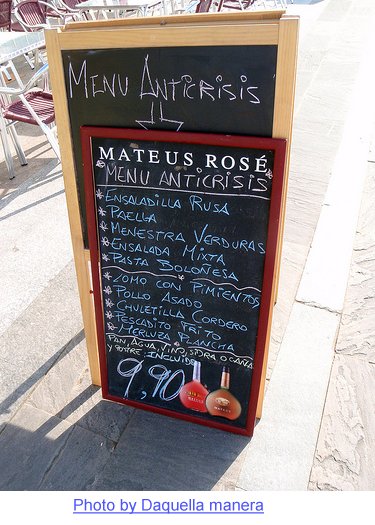 I realized when planning a visit to Spain, I was still missing one key piece of information. I could check on plane prices and hotel reservations, but what about once I got over to Spain. I had a co-worker who returned from a European vacation and told me that each meal for their family of four was a fortune in some locations and that they had to adjust and have a giant breakfast, early dinner and snacks in between.
I realized when planning a visit to Spain, I was still missing one key piece of information. I could check on plane prices and hotel reservations, but what about once I got over to Spain. I had a co-worker who returned from a European vacation and told me that each meal for their family of four was a fortune in some locations and that they had to adjust and have a giant breakfast, early dinner and snacks in between.
So I asked Laura (TheSpanishBlog.com what people could expect to pay for a meal while visiting Spain.
Laura’s reply:
In my experience Spain has always been, and still is, a very reasonably priced place to eat out and also to buy food in supermarkets. In the current “Crisis” climate even lower prices can be found. I have seen special “Anti-Crisis” breakfast menus in my town for 1€ (today 1 Euro is $1.32, conversion tool) that offer a cup of coffee or hot chocolate with two large pieces of toast or a pastry and three course lunch menus with wine and coffee included are commonplace for 7€. (Today 7 Euros is $9.23 see conversion).There are, of course, many other establishments offering higher quality meals for much higher prices. Most large cities in Spain have a good selection of top class restaurants and bars where you can sample food prepared by Spanish chefs really pushing the boat out and showing off. I would say, however, that the vast majority of Spanish restaurants these days are geared towards offering value for money in order to get as many people through their doors as possible.
Some areas in Spain are slightly higher priced than others. A meal in my home city of Bilbao, for example, will probably set you back a few Euros more than the same meal in my current city of Alicante. Barcelona, Madrid and San Sebastian are also on the expensive side. The major tourist regions such as the Costa del Sol and the Costa Blanca are usually the easiest places to find cheap meals as there is such competition to attract the tourists, but be careful as there are certainly many “false bargains”. I have had the misfortune of choosing a few very poor “budget” menus over the years (avoid cheap paellas!) and they have usually been in touristy beach-front cafés and restaurants. Places with gigantic menus offering everything and anything for rock-bottom prices usually equate to bland and instantly forgettable meals.
I find that the easiest way to find good food at good prices is to keep your eyes peeled for the busiest restaurants, bars and cafés. These won’t necessarily be the fanciest looking places or offer the fanciest sounding menus; in fact they will probably be the just the opposite. If you can find the places where the locals go regularly you are sure to enjoy a big and tasty Spanish menu for the best possible price. Spanish people love their food and they are not shy to voice their opinion when the meal they have ordered is not up to scratch. They might do this verbally in the moment or by never returning to make the same mistake again. When somewhere manages to secure a solid following of locals you know that it is good.
When hunting for popular local haunts you should be aware of the usual times of the day that Spanish people eat. An English person might want to eat their evening meal at around 5.30pm or 6.00pm and this will be an impossible time to gauge the popularity of the restaurants and cafés as for sure none of the locals will be out eating. Spanish people usually eat their evening meals between about 9pm and 11pm and their lunches between about 2pm and 4pm. A good plan could be to use the first day of your holiday to suss out the best places to eat. If you don’t fancy eating at the same times as the Spanish, then go for a wander after you have eaten making a note of all the busiest places. Be aware that not all restaurants will serve food as early as 12.00 noon or 6.00pm.
As a final recommendation I would also say that usually the best-tasting, best-value-for-money meals in Spain are the really traditional everyday Spanish dishes such as “Alubias con chorizo” (Bean soup with chorizo sausage), “Cocido de garbanzos” (Chick pea stew with meat and vegetables) and “Lentejas con jamón” (Lentil soup with Spanish ham). These are the types of dishes that have been cooked all over Spain for centuries. Everyone knows exactly how they should taste and so they demand excellence when they are eating out. The basic ingredients are extremely cheap and the dishes may not sound particularly inspiring, but when you are served a true plate of alubias, garbanzos or lentejas it really is a joy and you are guaranteed to be nicely full up until dinner time.

Photo by El Aderezo



